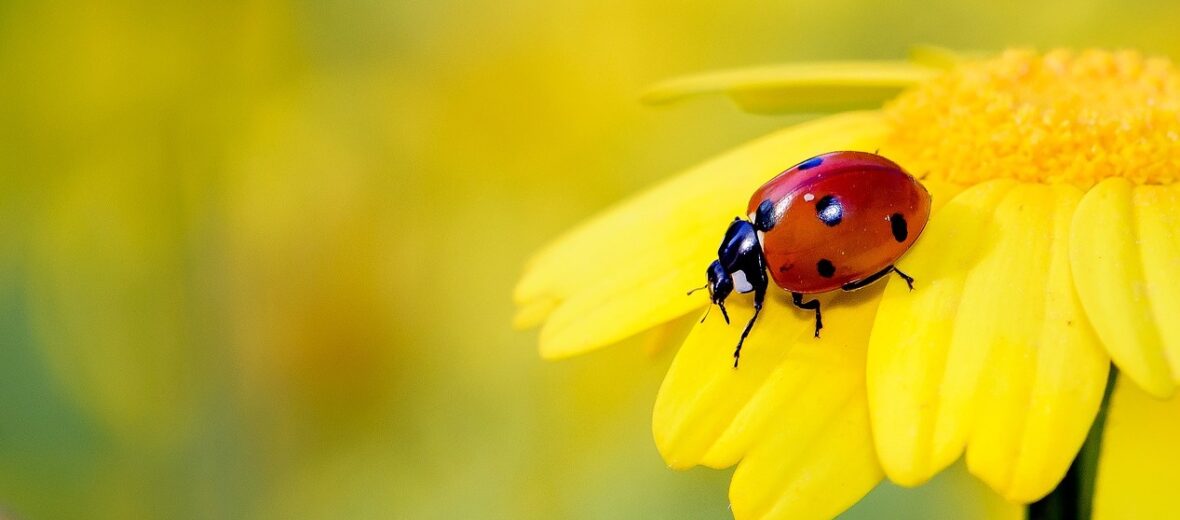
The ladybug, aka ladybird beetle, Mary’s beetle, or lady beetle, has been a part of worldwide culture in the form of folklore and nursery rhymes for centuries. These little beetles are even revered by those who aren’t a fan of bugs at all; with bug loathers even calling them, “Cute”. There are around 6,000 known species of lady beetles, worldwide; with 450 in North America alone. They dwell on every continent sans Antarctica. The ladybug may be cute but they are, in fact, voracious predators that feed on garden pests and help keep plants safe. However, there are also some species of ladybugs that eat plant matter. Due to the introduction of non-native species, land-use changes, climate change, disease, and changes in available prey, their populations are decreasing!
First the Stats…
Scientific name: Coccinellidae
Weight: Up to 0.0007 ounce
Length: Up to .39 inch
Lifespan: Up to 1 year
Now on to the Facts!
1.) First off, lets clarify something. The ladybug isn’t a bug, it’s a beetle. A true bug will belong to the order Hemiptera. Coleoptera is an order of beetles. The difference? Hemipteras contain bugs like cicadas and bed bugs, to name a couple. Coleopteras have wings sheltered by wing casings.
2.) In certain parts of England, they are known as bishops. No one knows why.
3.) Russians call the ladybug bozhya korovka, which can be translated into “God’s little cow.” This is in reference to their stoat, round little bodies.
4.) They can be red, pink, orange, yellow, blue, brown, grey, or black and often have black spots or stripes on their wing casings.
5.) Their exoskeleton is made of keratin, like our hair and fingernails.
But wait, there’s more on the ladybug!
6.) Larvae and adults eat plant damaging insects like they’re going out of style. An adult lady beetle can consume up to 5,000 aphids in their lifetime!
7.) Just as soon as they hatch, the larvae get to work eating plant pests like: aphids, thrips, fruit flies, and mites. They continue to devour these pest insects until the day they die.
Did you know…?
These insects were actually named after the Virgin Mary. There is 1 type that has 7 spots and they reminded people of Virgin Mary’s seven sorrows.
8.) When the weather gets chilly, these fascinating insects go into diapause (a form of hibernation).
9.) Their colors, spots, and stripes serve as a warning to would-be predators that not only do they taste terrible, but they can also emit a nasty odor from a chemical they release from their leg joints, if they feel threatened. The released yellowish liquid is toxic to birds and smaller mammals.
10.) Lady beetles mate just before winter and up to 9 months later the females will lay up to 1,000 tiny golden eggs in and around pest insect colonies.
But wait, there’s still more on the ladybug!
11.) If prey items are scarce, the female will eat her own eggs.
12.) The female will also lay infertile eggs mixed with fertile eggs on plants that don’t have an abundance of prey insects. That way her young have something to eat.
Did you know…?
Ladybird beetles can devour around 100 aphids a day!
13.) Like other insects, respiration (breathing) takes place via openings, called spiracles, found on the sides of the abdomen and thorax.
14.) The harlequin ladybug, initially from East Asia, has spread to portions of Europe and North America. These ladybugs not only infect native species with a lethal fungal parasite but they also eat local ladybugs!
15.) Another harlequin ladybug problem is when they infest plants with native species, the native ladybirds flee to neighboring vineyards. When the grapes are harvested, the ladybugs are accidentally handled and as a result, release their foul smelling/tasting fluid all over the grapes causing what is called ladybug taint: a stinky wine that tastes of asparagus or peanuts.
Now a Short Ladybug Video!
Be sure to share & comment below! Also, check out the Critter Science YouTube channel. Videos added frequently!
Want to suggest a critter for me to write about? Let me know here.




Leave a Reply